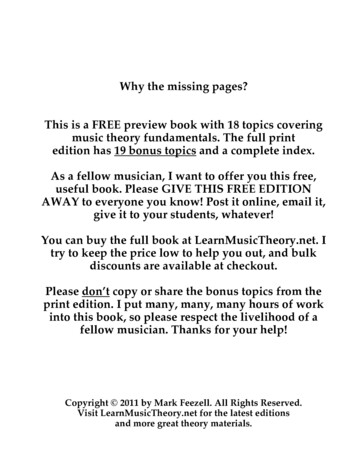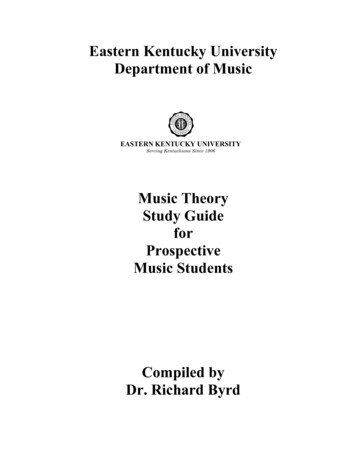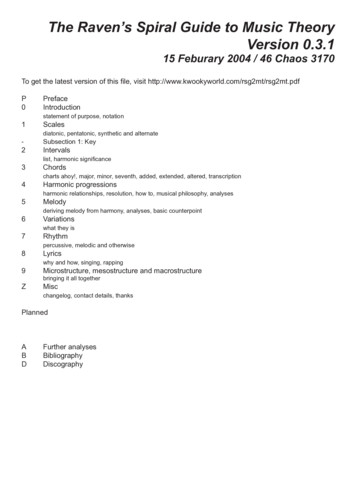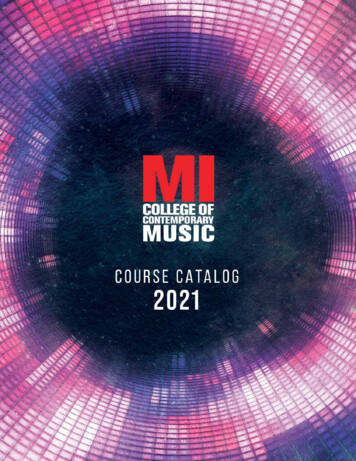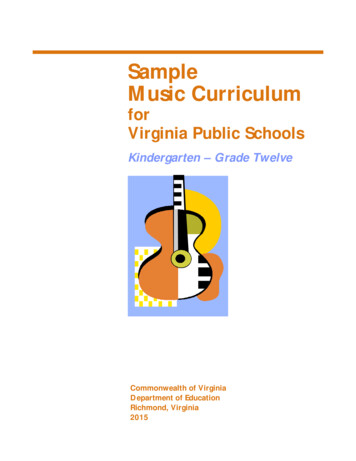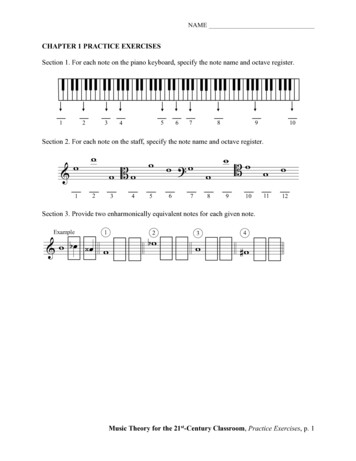
Transcription
2&NAMECHAPTER 1 PRACTICE EXERCISES5&1Section 1. For each note on the piano keyboard, specify the note name and octave register.HW1323ww& 112254w 33B w446w7w ?w5566ww7798Bw10w99 w881010Section1 2. For2 each3note on4the staff,the7note nameand1165 specify89 octave10 register.12&7HW6&ww22&w BwwwBw2134&wwwwBw w www wBwww ?65w 7 8 9 10w 11 12w ?wSection 3. Provide two enharmonically equivalent notes for each given note.11116HWExample23467bw1& w bœ ‹œ w2? ‹w #œ bœ bwExample51893w2!w3w1011124#w‹w4Music Theory for the 21st-Century Classroom, Practice Exercises, p. 1
2D! major scale21A major scale?&NAMECHAPTER 2 PRACTICE EXERCISESB! major scaleE major scale2Section 1. Using the WWHWWWH pattern, write the specified major scales without using keysignatures.HWD! majormajor on2. Giventhenewkey clefs?signature, specify the majorDOublebars?B!key.major scaleEmajorscale2723HW? bb b&bC major1 scale2534& ####&827&41? bHWsharps and bflats.bbbb###2bb#3bbbbb9##10####bb b ? b4#### #####7A! majorscale65? ### ###### ##1112bbbbbbbbb13bbbb#bbbbbb14bbbbbSection 3. Write the major key signature for each key given. Be sure to use the correct order3 for5553&48?&&1###1. A major6061& # # # # 65#& #5586. C! major?234#b b b b b b2.b B! major# # # # # #3. F majorb97. E! major10118. B major56# #4.# #D! major b b#b129. F major137#### ##5. D major1410. C major69& #### #& #6369?77&857479&?Music Theory for the 21st-Century Classroom, Practice Exercises, p. 2
&16. C! major27. E! major38. B4major#### #? #### bb bbbb#&bCHAPTER 3 PRACTICE EXERCISES#####Section 1. Specifythe minorkey10for each key11 signature given.12894169HWHW? bb?b b bb1. E! major1744879######2. C major23bbbbbbb10. C7 majorbbbbbbNAME65 3465 9. F majorbb3. G!major413bbbb#14bbbbb4. D major 5. F major567&# ####### ###bb b b bbb##bb##&bb7. D! major6. B major8. F major9. A! major?9101112138#### ##10. G major14major14. E major12. A major13. B! major# # # # # Section11.2.C!Writethe minor key signature and specified minor scale in each example.& 83 #?&63F harmonic minor scaleB melodic minor scale#### #(include key signature)(include key signature)#&4 85Section 3. Write the minor key signature for the given?key in each example.HW &89? A! harmonic minor scaleC melodic minor scale558794(include key signature)1. D minor2. F minor&G natural minor scale7. C minor6. B minor(include key signature)?HW1. minor: Ab is the mediant?3. F minor8. G minor(include key signature)4. D minor5. A! minorF melodicminor scale 10. E minor9. B! minor(include key signature)Section 4. Specify the key from the scale degree name.99891041092. 1.minor:Db is the subtonicF minor2. E minor3. major: B is the dominant4. major: C is the submediant5. minor: D# is the subdominant6. 6.major:Bb is the leadingtoneF minor7. A minor7. minor: Db is the supertonic&?11. E! minor12. C minor3. A minor4. G minor5. B! minor8. B minor9. G minor10. A! minor13. C minor14. D minorMusic Theory for the 21st-Century Classroom, Practice Exercises, p. 3
Œ ‰‰ Œ ‰ Œ œJJœ J# .Jœ œ JJJ#### w‰Œ.&? ####!45NAMECHAPTER 4 PRACTICE EXERCISESSection 1. After listening to each example, specify the meter (e.g., “compoundtriple”).Beethoven, Op. 57,I, mm. 78-80#1: Lin-Manuel“First Burn” https://youtu.be/r2ys-AimNbE?t 45 . # œœ Miranda,‰ Œ Stay‰ Together”œn œ œ œ œ œ œ œhttps://youtu.be/uSu6tcbMOu0œ œ œ œ œœ œ œ œ œ œ œ œ œ œ œ œ œ œ œ œœ œ œ œ œ œ œ œ œ œ œ œ œ œœ œ œ œ œ . # œ“Let’s#2:&Al #Green,14#3: Kennyf https://youtu.be/ko1gUVP461A?t 65p . Kirkland, “Dienda”œ.œ.œ#4:?Traditional outu.be/qH0iFkxQba4?t 9sœœœ.œ ‰ œ Samœ n œSmith,n œ œœ#5: Latch featuring . “Disclosure”œ . https://youtu.be/93ASUImTedo?t 2m6s46f49& & ##& !Section 2. For each example, specify the implied time?signature and the meter (e.g., “simpleduple”). ##& ! b&bœœ " "poco cresc.Ó œœœœœœœœœb n œœ œœ œœ œœ œœœ www? b bKrrœœ œ . 14 œœœ œb œ œ Corelli, Op.œ 5, No. 1, mm. 12-15Jœ ! w œcresc. &n #p wb œœœ œœœ œœœ œœœ œœœ œœœ œœœœœœœ n œ œ œ œ œ œ # œœœ œœœ œœœ œœœ # œœ œœ œœÓn Ó! K. 283, III, mm. 187-190bb ! j ! &! #### !w w ! ! ! ! ! wMozart,Ó Ó ! ! !!!!wœœ & ‰ œœ & œ # œ œ œ œ œ œ œ wwwwJ œ ? ## # pÓÓ ? œ# œ #œ œ œ œ nœ j ‰ jJ‰‰‰‰ & œj? b œR""Œ‰. . !2. Timeœ! !Signature:! ! ! Meter:! !!œ ! œ!! œœ ! !bp9j# œ##œ‰œœ # œ !œ œ23 !œ œ !œ œ& J!œ!!!!!&# ! nbœ&œ #œ œ œ œnœ?# œJ‰‰ #? n ‰!? ## !#&!?#!!!!!!&!b!3. Time Signature: Meter:?!!bœ œ œ œ # œ œ œœœ œ œ œ œ œ œœœb œœœœ!! ! ! ! !œ!!!!!!!stœ œ!J !pjjœœ ‰ œœMozart, K. 283, III, mm. 187-190!‰ & œjœp!!!#& !# ?& !23œœ4. Time Signature: Meter:## œ œ ! !ww w! œ! œ!nw n# Ó Óœœœœœ œœ œœ œœ œœœœœœœ! ? ## #Corelli, Op. 5, No. 1, mm. 12-15Corelli, Op. 5, No. 1, mm. 12-15Gervaise, "Pavane Passamaize" from Sixième Livre de Danceries, m. 7& b œ 24# ##!&1. Time Signature: Meter:1515œœ"œœ#Beethoven, Op. 110, III, mm. 124-125!!!!!!Music Theory for the 21 -Century Classroom, Practice Exercises, p. 4!!
6. F minor?1097. A minor8. B minor9. G minor10. A! minorNAME11. E! minor12. C minor13. C minor14. D minorSection 3. Use one note value (with one or two dots if necessary) to show the sum of all therhythmic values given.113Example115 .1.116117jœ œ œ œ œ œœ œœ œœœœœœ3.118 œ4.? œ œ2.119 œœ œ œSection 4. Specify the meter of each time signature.a. The meter of 4/2 is:b. The meter of 9/16 is:c. The meter of 3/4 is:11Section 5. Correct the incorrect rhythmic notation in each example in order to show the beats.Example1.3 ( œœ . œã4 J2.œ6ã8 œ6 œ ã8(3813.4ã4383œ œ œ œ œ œ œ œ œ œ)œ3 ( œœ œœ œœã4(379Incorrectœœœœ œ œ œ œ œ œ œ œ)œ œœ œœ œ œ œ œ œ œ œ œ œ œ)œ œ œ.œ œœJ3 (œ468 ( œœ œ 68œ œ œ œ œ œ œ œ œ œ œ)œ3 ( œœ . œ4Correctœ œ œ œ œ œ œ œ œ œ)œ œ.œ œœœœ œ œ œ œ œ œ œ œ œ œ)œ œ œ œ œ œ œ œ œ œ œ)(œ œ œ œ œ œ œ œ œ œ œ œ )Music Theory for the 21st-Century Classroom, Practice Exercises, p. 5
HW& ww1.ww2.ww3.wwwwNAME? ww4.5.6.bww? w#w# www& wbw# wwbwSection 1. Specify onlywthe number, not the quality, for each example.w1.2.3.6.ww? 4. w 5.w& wwwwwwwwww?bw?ww#wbwww1.3.4.5.w3www&Ex.www#www 2.ww3wwEx.1.1.2.4.5.6.2.w3.5.?3.4.wwww& wwwwwwwand size?for each example.ww#Section w2.wIdentify theintervalqualityww#ww2. w3.4.6.wwwwwb w& 1.b wb ww 5.wwb wbw1.3.4.6.w 2.? 10.w 5.11.#w# ww7.9.8.w& wbw# wwbb ww 12.w# w?w 5.wwwww#ww1.2. #3.4.6. #?&bwww#wb#wwb w& # wbwwwwabove the1.3. b5.6.w?16.4.givenwSection3.Write the2.14.followingintervalswwww13.15.#www note.17.# ww 18.b&b wwwwwww1. w2.3.5. #6. b# wwwww?4.&b& wbw#wwbw#ww1.2.3.4.5.6. #www?wwbwbbw& 1. m6 ww 72. P4 3. M3 4.b M6 5. M7 6. m2 #wwwwww?10.b w# wwwb ww 11.wb7.9.12.8. b?&Sectionintervals& 4.w Write the followingw below the given note. wwww#w7.9.10.11.12.8.w?#wwbw#w#ww& 1. #M2 bww3. M7 4. M2 2. 4 5. M6 6. P5 ww?bwbwwbww#w#w& 13.#w?wwbw14.15.16.17.18.#w& #w w# wb w ? 4. wM6 5.bm3 wb w&ww1. º5 2. M3 3. P4 6. M2 ww13.14.15.17.18.b?16.w#ww& 7. m3 8. m6 12. m7 9.#P4 ww ? 10.# wm6 11.b w 5 bwbw&bww& 1. m6 w2. P4 3.#M3 M7 6. m2 ? 4. M6 5.5.bM3 wwbw#w& 1. m6 2. M2 3. b 5 4. P4 6. m3 www#w?w1. m6 2.P4 3.M3 4.M6 5.M7 6.m2 b wwww& 13. M3 www ? 16.wº5 17.w14. m2 15.wP5 M6 18.# 5 &? 4. M2 w3. M7 2. 4 5. M6 6. P5 & 1.7.M2 wM7 wwww8. M2 9. m3 10. P4 11. P5 12. m3 3.# M7 1. M2 2. w 4 6. P5 bww 5. M6 wwww? 4. M2 w&bww&?#www8. m6 10. wm6 12. m7 11.b 5 7. m3 9. P4 & 13.wwº5 14. 4 15. m2 16. M3 17. M6 18. P5 ? 10. m6 11.# 5 8. m6 12. m7 9. P4 w& 7. m3 wwbw# ## #wbb wbb b b?ww b 15.bP5 & 13. M3 14. m2 16. º5 17.#M6 18. 5 www#wB majorb minorEx.1. majorminor13. M3 14. m2 15. P5 16. º5 17. M6 18. 5 MusicTheoryforthe21-CenturyClassroom,Practice Exercises, p. 6##bb b b&CHAPTER 5 PRACTICE EXERCISESD # & QualD # onlyD # onlyHWHW168HWD # & Qual174D # & QualHW180HW168Write above168HW174174192iting below180Write above180198HWWrite aboveHWHW192 192198198232st2. majorminor3. majorminor
# # # www&&8.1.13.14.15.b#www# # # wwwwww?wb#wb?#w&# www# # ww EXERCISES& # # www 6 PRACTICE# wwwCHAPTER60489.2.bb wwww##ww# # ww17.18.10.11.12.3.4.5.NAME16.wwwwb ww#w? wwb ww& # # wwb b wwb b b www ? b b 2.E 3.A!sus2C #&b wwwwb www# # #Cww# wwwwww ? 3.b bEx.1.2.4.w& w msus chords.16.17.SectionWrite the14.specifiedtriads2.A3. 15.E!andsus44. G! 5. F º& 13.1.2.Dm?&&#b ‹wwwwb wtypes (M,m,3. , º) using 4.5.symbols.6.Section1.1.Analyze the2.triadlead-sheetSus2and sus4 chordsare also included.5466426072HW487866&5484728. E2. E 7. Fsus41. Bm9. Gsus23. A!sus2# # # wwww# ww6. Fº12.ww# ‹5.w18.6.B!sus211. C m5. Dsus410. Dº4. C 12. A 6. Fº?&HW &14. D! 15. F & 13.b1.bGmwwww 16.4. EG!!m ww 17.5.bBFww º 6.18.B!Cºsus2ww2. ADm3.E!sus4#bw# w& wwww ? wwww?BHW &&ww? bwwwb www#wwwwE 2. B9.!ºGsus2/D!F /A Dm/A8.10.3.Dº11. C m 4. Em/B12. A & 7.1.Fsus4? 2. 3.E!/B!1.4.5.?6.Ex.?&&&Section 4.Writespecified inverted5. C m/E the14.6. Gº/D! triads.7. Dº/F8. A/C D! 18. Cº15. F! 16.!E!m17.! B!!&& 13. Gm!?HWPRACBbw&&w?EXER!!!!!w!& Ex. Fm/C1. G/D2. Bm/D3. D!/F4. Eº/B!&Section 3. Analyze the following inverted triads using slash notation.6090786629484722982907829684302!&& !&Incorrect CorrectIncorrect? !bw& # ww b ww !# # www& w296?308!!!!Section 5. Correct the misspelled triads. Label your corrected spelling with lead-sheet notation.All of the examples are in root position (the lowest note is the root).9303308290&&3027.C mEx.? wb bbwwwwww ? bb#bwwww#b #b ww! &!&Ex.Cm!!!Correctb # www!IncorrectCorrect!b # www!IncorrectCorrect1.2.3.!!!!!!Music Theory for the 21st-Century Classroom, Practice Exercises, p. 7
#### ww### w11b b b n wwwwIncorrectCorrectCHAPTER 7 PRACTICEEXERCISES(œ œ œ œ œ wœ œ œ œ œ œ œ ) ( œ œ œ œ œ œ œ œ œ wœ œ œ )Section 1.3Labelthe followingchordswithlead3sheetandœRomannumeralsw. symbolsœb 4#(below).b###bJwbEºEx.# #www1.& b www(œ œ31. ã&4 bœ wwwœ1.# (œ œ& 6ww œ2. ã?8b w## ww2.3.4.5.NAMEœ œ# œ# œ wœ œ œ# œ œ œ )# #3 (wœ4wœ œ œ œ œ œ œ #œ #œ œ œ )bb n wœ #œ# œ w œ œ # ww# wwbwww2.3.5.4.6.#w#(œ œ b bœb b œ œw œ œ #œ# œ œ wœb b bœ wœ œ wœ b b œ wœ œ œ #œ ) wœ œ)www6wwœ œ#wœ# #. w œ œ# wœ ##w8 ww# #ww# w## wJbbbn w 5. A:iiºEx.wd:1. E: w2. e: #) 3. b:(4. c:(? # 6w œ œ œb b œ œ œ œ b bœ œ œ œ # #œ 6w œ œ b œb bœ œw œ œ #œ# œ wœ œ œ ) œ œ œb wb3.Sectionã 2.8Given the Roman numeral and key, write8the key signature, notate the triad and labeliiºEº 1. E:Ex.Ex. d:1. 2. e:2. 3. b:3. 4. c:4. 5. A:5.1121. G:2. E !:3. B !:(above).6. D:the chordwitha lead-sheet1.2. symbol3. 4. f :5.4. 5. f :6.b b ww b b ww # # # w b b b b w # #b11. w 12.&7.wEx. F m/A8. 9.1.w 10.3.ww# ww 2.# # # # ww # # # w?##bw# ww?b wwb& & www&www n w wwwww ##w ## w? # Ex.w E: ii/3rdb bbbb#w1.f:V2.D:IV/5th3. b!:viiºbbb w b www? # #1.#Label# ##4.# f w:numerals# 6.wwD:4.w lead-sheetw 3.abovebbelow1.#G:2. #E !: symbolsBb!: 2.3.5. f :Section 3.and Romanand analyzethetype ofwbw?that ends the phrase. &?cadence&12. e:10. D:7. c :9. d:11. g:7. 8. A:8.9.10.11.12.##1. Columbia,# TheGemoftheOcean(https://youtu.be/Iyn3HEVFOhM?t 8)# # w3. A!: ii b b# 4. b: iiº1. g: III #2. A: viw##w#b&wof the Ocean"wwwwwwwww T.8.Shaw"Columbia, the GemDavidw 6.5.7.Lead-sheet symbols:?wŒ # œ œ œ b &w # w#? # # ww # #&.œœwcœœ œ œ 8. G:œ wI/5th. œ œ ##œ #œ5. e:œ viiœº/3rd#w&œœbwb6.d:VII7.C :IVœ œ œ w œœ 10. D:#124383387124391130?7. c :395130?# c Œ# !œ œ œ œ!&Roman numerals:?4028. A:?#G:1!2!9. d:œ3œ! œ œ!11. g: 12. e:œ! œ œ œ! œ œ œ!456!Cadence type:!!Music Theory for the 21st-Century Classroom, Practice Exercises, p. 8
NAME2. Could You Be Loved (https://youtu.be/pOm4MYha9jg?t 23)Bob Marley"Could You Be Loved"# 4V # 4 Óœ (œ) œ œ46 Ó‰ œÓ(œ )(œ)(œ ) œ .ÓJ#j j j j& # 44 ‰ œœj ‰ œœj‰ œœj ‰ œœj ‰ œœj‰ œœj‰ œœj‰ œœj ‰ œœ ‰ œœ ‰ œœ ‰ œœ ‰ œœj ‰ œœj‰œœj‰ œœjœ œ œ œœ œ œ œœ œ œ œœ œ œ œ? # # 44 œœ‰ ‰ .œ œ œ ‰ ‰ . r œœ ‰ ‰ . œ œ œr ‰ Œ œœ ‰ ‰ . œœœ ‰ ‰ . œ œœ! œ ! œ œRœ( ) œ( ) œRRCould you be loved46and be loved?1234Cadence type:50Vb """"""""""""0&b """"""""""""?b """"""""""""Vb""""""""&b""""""""?""""""""bMusic Theory for the 21st-Century Classroom, Practice Exercises, p. 9
?5.Menuet, BWV Anh. 116?6.&# 3 5. e: œviiºœ/3rdœ œ œ 6. d: VIIœ EXERCISESCHAPTER&4 8œ PRACTICEœ œ8.J.S. Bach&9NAMEœ œ œœ7. C œ: IVœœœ7.œwwww## # 1.wwAnalyzeb bthe given# #withwww lead-sheet# # # symbolsww chordsww and Romanb ww numerals below.wwSectionabovebbbww& Dwwwwwø7/C œœ? b# 3œ œ3.#œe:œ ww œ œ #4. E:# # œ5.#d:4 2. Eb!b:œ œ6.bB!:#œœw1.b b:œw##wwwwwww& b wwwww# wwwwwwww1324 w56www 4.bG:viinø7w/ 7th 1. g:?Ex.b bE!b:# # www 2. D:# # # ww 3.b bc :wwww 5. d:#wwwwwwbnbwwbww# œ œ œ œ œ œ œ œ œ œ œ œ œ .&8. G: I/5thSection 2. Given the Roman numeral, provide the notes of the chord and the lead-sheet symbol( )( ) 11. c: 12. G:above. 7. f: 8. D: 9. f : 10. g:####&? # œ œ œmaj7/DG4131. A: ii7Ex. e: IIIM7/5th7Section3. Analyze19&bbbbbb bœtheœ1. a: iv744b b b b b b&b?Lead-sheet symbols:143bbbb4258harmoniesRoman numerals:2. D!: iii7a!:######5. B: IVM7/3rdbbb#aboveand RomanCadence type:Kevin Briggs, Kandi Burruss,Tameka Cottle, Lisa Lopes4. D: vi75. c: iv7/3rd6. G: IM7#œ# œ œ œ b b n œ œ œ œ#œœ (œ ) œ œ (#œ) œ4. c: V73. D: viiø7œ œ œb œœ9. b: viio7/5th 10. B!: viiø7 11. e: iiø7/3rdœ219101112in theexcerptswithlead-sheetsymbols8. A!: ii7œb bœ3. f : viio7œ œœb b bœbœ###? b b7.bf: V47 œbbbb 4?bœ##2. g: iiø7numerals below."No Scrubs"312. F: IVM74b! Sonata! K.! 545,!I ! ! ! ! ! ! ! Wolfgang! ! Amadeus! ! Mozart!& b b b b b b ! Piano145145œ œ& 44 Allegroœ.(œ)œ œŒœ œ œ Ÿœ (œ)œ œŒ? bb b b ! ! ! ! ! ! ! ! ! ! ! ! ! ! ! ! !bbb& 44 œ œ œ œ œ œ œ œ œ œ œ œ œ œ œ œ œ œ œ œ œ œ œ œ œ œ œ œ œ œ œœC:1234567Cadence type:149&!!!!Music Theory for the 21st-Century Classroom, Practice Exercises, p. 10
19&& 1. a: iv7192. D!: iii7##########3. f : viio7o77EXERCISES1. a: iv72. D!: iii3. f : viiCHAPTER9 PRACTICE#b b bNAMEbbb 7 #4. D: vi75. c: iv /3rd6. G: IM74. D:vi77/3rd5. c: iv6. G:IM7? bb##bb?b b wbbbwb&w#w? bb b##bbbbbb8. A!: ii79. b: viio7/5th 10. B!: viiø7? 7. f: V7? wb&ww? bwb425435### w13b wbDay One:Section 1. Write the circle of fifths progression in the following keys with root position triads.Label Romannumeralsbelowlead-sheetsymbols77. f: V8.A!: ii7and 3.9.P5 b: viio7/5th10.B!:above.viiø7 11.e: iiø7/3rd 6.12.m7 F: IVM75. º5 1. º7 2. M3 4. M7 425441I1.m3 1IF major1435453441435457441453bbbbbbbbbb4614654572. m6 3. P5 2342344. º7 55F m9. 6 F 7/C 10. m7 &&&?8.FF º/A7 M3 7. º7 5. b:5. g:bwI5. M3 6. M6 786I7866. D:6. B:&&?7 º5 11.DmajDm/F7. f :7. d:12. P5 FmAm8. A!:8. F:Section 4. Correct the rhythmic notation of the following example.CorrectIncorrect7G º/BBA!maj(()4?ã&&4 œ œ œ œ œ ! œ œ .œ œ&6ã&8 œ œ œœ&459œ œ œ œ œ œ œ œ œ œ œ œ œ œ œ œ1. a:465w12. F: IVM7#? #wbw& #wwww 13##8. M3 10. m7 11. º5 12. P5 & 7. º7 9. 6 II? 5 w 6 # w 781234bw&Ci B!m# w wD Dº/Fw im? b b? 7 6. m7 812 ? 34565. º5 3. P5 1. º7 2. M3 4. M7 &&B?minorbb 1.I f:I?4. E:132. A:3. c:theSection 2.Review. Write the followingintervalsabovegiven note.w7812w3456 w& bbwIwwI## # 1 F º7 2F 7/CAm83 3. P5 4 54. º7 Dm/F65. M3 7?1. bm3 2.m6 6.M6 &ww?#w& ###w &#ww&&?II5. º5 6. m7 3.2. M3 4.# wM7 b wP5 & 1.wº7 5.w 7 8. F:g: w6.B:w8123457. d: 6iiSection7.3.Giventhe lead-sheetsymbolandm7 key, writethekey signature,triad or seventhº7 Review.8.M3 10.11.º5 12.P5 ?9. 6 7812345w6&wbwchord, andnumeral.wBwb wRomanG º/BA!maj7Am/GB!mC mDDº/F?4.º7 1. m3 2. m6 3.P5 5.M3 6.M6 ?&&&&? # 3.w E!: w2. c b:w4. G:& w 1.1. f:a:2.A:3. c:4. E: ww45346111. e: iiø7/3rd4662. c :?œ œ œ œ œ œ œ œ œ œ œ œ œ Am/Gœ œ œ)3. E!:4. ssroom,p. 11(œ œ œ Fœ /Aœ œ œ œ œ œ F œm œ ) (œ œ œ œDmajœ 7 œ œ œ Practiceœ œ œFmExercises,œ)œ ?œ5. b:œ.6. D:7. f :?8. A!:
NAME17CHAPTER 9 PRACTICE EXERCISESBo/DC/EDm/FC/GDay Two: CSection 1. For each cadence, label the chord(s) involved.GPC DC AC œ& 44 œœœHC 243? 44 œœœœœœœœœœ œœœœœœœœœœC o/3rdIviitheI/3rd progressionsii/3rd withI/5thV symbolsIabove and RomanSectionC:2. Analyzefollowinglead-sheetpassingnumerals below.FUNCTION:& b www?wwwwbwF:1253pre-dom.tonic2## w& wwwwwwwww3wwwwwww4wwwdom.####ww# # # # wwE:1b b wwwtonicwwwwwwww23wwwwwwwwww4wwwSection 3. For the progression, do the following:(1) Given the Roman numerals, write the triads or seventh chords(2) Analyze the harmonies with lead-sheet symbols above the staff(3) Analyze the harmonic function of each harmony using the abbreviations “ton.” fortonic function, “dom.” for dominant function, “pre-dom.” for pre-dominant function,and “ton. prol.” for tonic prolongation function(4) Specify the cadence that ends the progression? ## wwb:1 2# # 4& # 4 www& D:ww I wwww1473261FUNCTION:?#479w? b 4b 4G:1g:FUNCTION:w2wwwiw3wwiiiww3bb wwB!:41wwwwvi7ww2 34wwb b b ww7wii /3rd wbbb wwwVwwww I Cadence:E!:41234Music Theory for the 21st-CenturyClassroom,Practice Exercises, p. 12VIiviiø7/3rdV7iCadence:
NAMECHAPTER 10 PRACTICE EXERCISESSection 1. Fill in the blanks in the following table.Non-Chord Tone TypeApproached byLeft bysame tonestep upleap in opposite directionstepstep in same directionleapSection 2. For the following examples, analyze the harmonies with lead-sheet symbols above thestaff and Roman numerals below, then label the non-chord tones (the notes in parentheses).164 Œ œ ‰ œj œ&4Stop!in the4 Œ œ ‰ œj œ&4œœ œœ œœ? 44œœœœœœC:œœjœ.( )œ name(Œ (œ ) œ œof lovebe - fore youjœœ .) œœ œ . œ œœœœœœœFmaj7Œ (œ ) œœœ œœ œœœœ œœ( )œœœœœœœ( .) œj break(my heartjœœ .) œœ œ. œ œœœœœœœœ!!!!!!!!&!!!!!!!!?!!! (continued! on next page)!!!!143&Holland—Dozier—Holland, “Stop! In the name of Love” https://youtu.be/tuei1XUAGRo?t 52s143151Music Theory for the 21st-Century Classroom, Practice Exercises, p. 13
15NAME### 2& 4C 7Bm/D!# # # 2 " (œ .) œ œ( )& 4 œ œ? # # # 2 œœ4### œ .&JBm/Dwun -137### œ&Œœœ(œ ) œ ( ) œ # œœœ#œ)œœœœ œœ Jœ œ œR œr œr( )R RMai,œœœœœ( œ)œ( œ .)( )-œœ#? ## œA:!(f : V137C 7- der - schö - nenMo - natjœ" œœœœœ œ œJ‰" œR" œ( ) œœœ#œImœœ‰" œRalsœœ œ (œ ) œœœJ" œRSchumann, Dichterliebe, Op. 48, 1. “Im wunderschönen Monat Mai”https://youtu.be/Nn0MRCmJyQo?t 5Music Theory for the 21st-Century Classroom, Practice Exercises, p. 14
8# 4 œœ& 4œ œ (œ ) œ (œ) œ (œ ) .œ# 4& 4 wwwwwwDay One ? # 4For the following Section 1. 4examples: Analyze motives using numbers (1, 2, etc.)Take myhandI'm a stran - ger NAMEin par- a - diseAll lost in aCHAPTER 11 PRACTICE EXERCISES Œ œ œ (œ ) œ( )wwwwww Label lead-sheet symbols and Roman numerals when blanks are providedLabel non-chord tones for notes in parentheses (Note: Even though there are 11 blanks for motives, there are only six motives in this exampledue to motivic alteration.)Motives:b 4 œj œ œ .œœ .(œ)œ .(œ)œ .(œ)œ œ œ(œ) œ . œ (œ)œ (œ)bœœ.& 4 ( ) œ œ œ ( ) œ ( )œ œ œ œ(œ)œ147Ah14728AhOohb 4jj& b 4 œœ œœ . œœ œœ . œœ œœ .Motives:œ œ. œ œ. œ œ.# 4C?& b b 4 œœ (œ ) œœ. œ(jœ)œ # œ (œ) œ. œj# œ # œ œ n œ nœœ. œ œ( ) .( )Lead-sheet:jœœœjœjœœœjœœœ .œ. œ. . .œ œ (œ )œ (œ) œ œ (œ)(œ) œFranks,Thomaz, “See You Again” https://youtu.be/RgKAFK5djSk?t 3m20s? #Puth,œCœœœœœœœœ œ œ . . . œ. œ. œ œ. œœœ. lead-JSection 2. For the following example, alter the given motives as. specified. Also, provideB!:sheet symbolstones.e: and Romannumeralsand analyze non-chordLead sheet:Motives:12œ (œ)(œ)œœœœ (œ)œ(œ)ww? c wwww&cC:1 aug.œwww2 aug.1œ œ2 inv. 402&Music Theory for the 21st-Century Classroom, Practice Exercises, p. 15
8Lead sheet:21Motives:1 aug.2 aug.œ& c œ (œ)œ (œ) œ œ (œ)(œ)œ œSection 3. For the following example: wwwww? Writewthelead-sheetsymbolscWritewwthe chords as whole noteswin the bass clef staffb cb&œ œ (œ) 1Motives:? bb cg: iœiv1 int. ch.1œ2 inv.NAMEœAnalyze non-chord tones, including the ones you writeAlterthe given motives as specifiedto fit the harmonyC:Specify the cadenceLead sheet:œi 1 inv.œ1 inv.V7Cadence:&b406b? bbMusic Theory for the 21st-Century Classroom, Practice Exercises, p. 16
NAMECHAPTER 11 PRACTICE EXERCISESDay TwoSection 1. For the following examples:Analyze the motives using numbers (1, 2, etc.), noting motivic alterations whenapplicableAnalyze subphrases using letters and primes (a, a’, b, etc.)Label lead-sheet symbols and Roman numerals when blanks are providedLabel non-chord tones for notes in parenthesesLead-sheet:Subphrases:# 2 œ (œ)œ(# œ)œ . œ œ . œ . œ œœ J& 4 JJ œ œJ œ (œ) œ œ (œ) œ # œ . (œj) œ .ÍMotives:e:iiviiio ViivVSchumann, Album for the Young, Op. 68, No. 16, “First Loss” https://youtu.be/Dbb VGJXaSUto 10s410&#(continued on next page)Music Theory for the 21st-Century Classroom, Practice Exercises, p. 17
NAMESection 2. Listen to the following example and determine the number of phrases. Analyze thechords with the lead-sheet symbols above and Roman numerals below. Label the non-chord tone33type for notes in parentheses.## 3& 4 .p? # # 43 œœœ.Lead-sheet:447D:œœœ.457œœœ.œœœ.## .& œ̇ œ œœ œ œ? ##œ œ œœ œ œœ̇œ . œœ œœœ œ œ## œ . j& œœ œ (œ ) œœ? ## œœ œ œœ œœœ œ. .œœ œœ œœ (œ) .œ œ œœ œ œœ̇œ œœ œœœ̇œ . œœ œœœ œ œœ. œ. œ.œœœFœœ œ œ œ.œ œ œ3œ œ œœ œ œ. . .œœ œœœ œœ œœ œœœ œœ œ .œ œ (œj) œ ( )œ pœ œ œœœ Œœœ # œ (œœ ) œ (œœ ) œ œ̇ . n œœ œœ( )œ œ œ(skip this bar)## .( )452Œ462HandelXerxes: “Ombra mai fu” https://youtu.be/U9Jh7DF1nxY?t 56&?#Music Theory for the 21st-Century Classroom, Practice Exercises, p. 18!!!!!!
NAMECHAPTER 12 PRACTICE EXERCISESFor each song, fill in the beginning and ending time for each section, label eachsection type (verse, pre-chorus, chorus, post-chorus, interlude, introduction, A, B,or C section, etc.), and the number of bars in each section of the form. There maybe more lines provided than needed for each example.a. Bahler, “She's Out of My Life” https://www.youtube.com/watch?v 6DQJPL9Yuq0Time : Section type: , barsTime : Section type: , barsTime : Section type: , barsTime : Section type: , barsTime : Section type: , barsTime : Section type: , barsTime : Section type: , barsb. Lennon–McCartney, “Penny Lane” https://www.youtube.com/watch?v S-rB0pHI9fUTime : Section type: , barsTime : Section type: , barsTime : Section type: , barsTime : Section type: , barsTime : Section type: , barsTime : Section type: , barsTime : Section type: , barsTime : Section type: , barsTime : Section type: , barsTime : Section type: , barsTime : Section type: , barsMusic Theory for the 21st-Century Classroom, Practice Exercises, p. 19
8NAMECHAPTER 13 PRACTICE EXERCISESFor each excerpt below, do the following: 48Label chords with Roman numerals at the ends of phrases to determine cadencesLabel cadences by type (PAC, IAC, HC, PC, DC)Examine the motivic structure to determine if a phrase is a sentenceCreate a diagram of the form using cadence abbreviations (HC, DC, PC, IAC, and PAC)and letters to designate melody (a, a’, b, etc.). Use the “prime” symbol (’) to show if amelody ends with a different cadence. In this chapter, the prime symbol should not beused to represent embellishment of the melody or changes in the harmonization orregister.Name the form of the excerpt (sentence, parallel period, contrasting period, asymmetricalperiod, parallel double period, repeated phrase, repeated period).1. Mozart, The Magic Flute, “Ein Mädchen oder Weibchen” https://youtu.be/CI0hJLioGF0j2œ&b 4‰? b 42 ‰F:œ œ& b œœœœ ‰J? b œj ‰œ œ œ œ œ . œ œ . œ œ œ œ œ œ . œ œ . œ œ ‰ œjœœ œœœœœœ ‰ œœœ ‰ œœœŒœ‰œ‰œ Œœ JJJJœ ‰ œj ‰ œœ ‰ œJ ‰Œœ ŒJJœ œœœœ ‰Jjœ ‰œ. œ œ œ . œ œ. œ œœœœœ. œ œ. œœœœœœ ‰ œœ ‰ŒœJJj ‰ œj ‰Œœœ3&bj‰œœ œœœ ŒœœŒ657?b(continued on the next page) Music Theory for the 21st-Century Classroom, Practice Exercises, p. 20
NAME472. Mozart, Piano Sonata K. 333, I https://youtu.be/PmO3Wlono6w?t 351632b& b c œœ .? b b c œœ . œœœ œ œ. . œ.œ œ.œ.œÓ ŒB !:636b&bj#œ? bb640b&bœ.? bb œ œœnœ œ œ œ œ œjœ‰ œœ œ Œœœœœ .œ.Ÿœjœj œ bœ. œJ œ œ J œ œœ œ œ œ œœœ œn œœ œ œœ œŒjœ œ œjjœ œ œ œ œ œ œ œ œj œ œ œj œ œ n œ œ # œ œ œ n œ œœ.‰œœœœœ œ œ œ. . .œ œ.œ œ œÓ ŒŒœ œ œ œœŒŒœœœœ œœœœœ œ œJœ&œn œœœ œœœ œœœœ œœœ œ nœ bœœ œ œ œœœ œœœŒ?n œ œ œ œ œ œ œ b œ œ œ œ œ œ œœ œ œœ œ œ œ œ œ œ œ œ œ œ œbb œ . œœ œœœ œ œ.œœ œ&œ œ. œ.œœnœ œ œ œ œ œœ œ œ œœœœœ? bb ‰ œœœœ.œœ648&#?#!!!!!Music Theory for the 21st-Century Classroom, Practice Exercises, p. 21
wwwwwwwwwwwwwwwwww63wwNAMEwwwwwwwwwwww& C:wwœœwœœœ œ # œ œœœw# œ wwwww&www6ww3wSection 1.AnalyzeRomannumerals4 Vsymbols6wfigured1. wA :V /vi the triads2. E: Vwith/IV lead-sheet3. D :/ii 7 above4. c:Vand/III5. g:V 6/V6 with7667 staff.6 2wbass inversion symbols6belowthewœww œ œwwwwœ œ œ œwwœww œ œ œ .œœ.wwC:œ&? 3 wwwœ . œ œwœ œ . œwwww œ œww.œœ.4 œ œ.œœC: www 3 ww 333www&wwwwwwwwwww wC:c w && b œœw # œœ n # ww # # b b œ œ seventh chordstheabove and RomanSection 2. Analyzewith lead-sheet symbolsnumerals withC:wwwwwfigured bass inversionww symbols below wwthe staff.ww&?wwwwwc œœ ww wwwwwC: www&w # n6 wb7ww 64w# 5wb&45645648675685687466b5 C: accidentalswithout4 with and 6 withaaccidentalsbefore anumbers refer to theslash through it meannumber affect that3rd theabovebasschords using lead-sheetraise thosesymbolsintervalsabove and intervalthe bassSection 3. LabelgivenRomanabovenumeralswithabove the bassfigured bass inversion symbols below.870b&bbLead-sheet:? bbb6?wwww##Rom. num.: 1. c:874##Lead-sheet:ww#wwbwwwwb3. F:2. b:#b b wwwb&b wwww? # # w&### ww#?ww####wwww4. D:b b b b wwwbbb wb&Section 4. Write theo7specified chords. Analyzethe chords with lead-sheetsymbols. Include keyM7/7th71.b:vii/5th2.D :IV3.f :V4. E: ii/3rdsignatures.Rom. num.: 1. D:1. E: IV6?& # # # # ww? # #1.# #A:wwI6Lead-sheet:2. g:3. e:2. c: iiø433. G: V564. f:4. d: viio6## w# #?b b b wwbb#& b wExercises, p. 22Music&Theoryww for the 21 -Centuryww Classroom, Practice2.4. g: viio6ww F: ii42 # # # 3.wb: V65b# #bb bb(continued on next page)st
NAMESection 5. Analyze the excerpt using Roman numerals with figured bass inversion symbolsbelow and lead-sheet symbols above. Analyze non-chord tones.2 examplesLead-sheet:& 44 œœ? 44 œœC:œ(œ ) œœœœœœ œœœœœœwwœww( )J.S.Bach, Chorale 175, “Jesus, meine Zuversicht”884&? Music Theory for the 21st-Century Classroom, Practice Exercises, p. 23
NAMECHAPTER 17 PRACTICE EXERCISESDay One.Section 1. Approach each chord with its secondary dominant seventh chord (whose root lies aperfect 5th above the root of the chord of resolution). Label chords with Roman numerals belowand lead-sheetC symbols above. Am7Dm7G& 44 ?4?444 4 91085858989ton. 4?4?&444 ?C:C: 44 C912493493914?V77/7V / viC:IC: C:FUNCTION: V77/V /ton. prol.7A # V77/V /V7/iiC: I 7ii wwww wV77/V / Vpre-dom. # n V77/V / 7Ddom.GV77/V /V7/Vww ww w VSection 2. Analyze the following secondary dominants. Include lead-sheet symbols above.FUNCTION: ton.ton. prol.pre-dom.dom.##Lead-sheet:b # wwwww&501w501? # # w#b: F:12? bb&bb508508920? bb b? b515515522522b w b b b b wwwbb b w#ww# # wwc:3G:4 (continued on next page)#### # www#### wb b b b b wwwbb b b wE:5 f:6 Music Theory for the 21st-Century Classroom, Practice Exercises, p. 24
NAMESection 3. On the empty staff below, copy the notes from the upper staff to the lower staff whileadding the specified non-chord tones. (Note: LNT lower neighbor tone; UNT upper neighbortone.) Realize the lead-sheet symbols using quarter-note accompanimental texture. Below thelower staff, analyze the chords using Roman numerals with figured bass inversion symbols.920bb 4jb.& 4 œ œ œ œ œ œ LNT PT UNTPT? b b 44b924b& b b 44? b b 44bRom. num.:PTchro.PT DN APPwCmFmD7/F Gbbb&928? bbbbb& b933? bb939&bbbbMusic Theory for the 21st-Century Classroom, Practice Exercises, p. 2567
&bb# n wwwn wwwc: V/IV920476V/Vchro.48167V/VIIPT PTbb b cj7 E 7 F7 DB 7œ.& 17 PRACTICEœœwCHAPTEREXERCISESœwwœ œbbwbwwwwwwwn wwnw& Two.b n www#wDayww? b c wSectionb1.bc:Writelead-sheetsymbols above.V7the/IVfollowing secondaryV7/V DNAPP as IV)PTLNT PT UNTC7key signatures.924n ww?& b b b cCmD7/F Fm? b 1. cE : V/iibb(same as VII7)2. g: V7/VIG3. e: V24/iv4. A: V6/iiSection 2. For the following example, alter the given motives as specified. Add anRom. num.:accompanimentaltexture of afterbeats.Analyze the Romannumerals usinglead-sheet symbolsabove the upper staff.928œ .œ œ .œ œ œœbc‰œœ&JFœœœ œœ œ? b c ‰ œœ œœ œœ ‰ œœ œœ œœJJmot.1mot. 2F:&b?b www#### wwb w1. F:b& b b b n www? bb wbb6. A :‰œmot. 2 aug.#### # ww2. E:# nwww# wœG7/BDmmot. 1C‰œmot. 2bb w#wbb n ww3. g:#####1 inv.œ2. invw# # # www4. b:b b b wwwbb b wb5. c:bb wbb wbb wwwnwnww# ww p. 26# # #21# -CenturywMusic Theory for theClassroom,wb b b b b PracticebExercises,7. G:st8. f :9. D : 10. D:
97522## c27&wwwwwM3NAMEm3CC /B # wA m3Dmj bœ œ j#œw œ EXERCISES?#44## #œjc18œPRACTICECHAPTERœœœ&œ œ J œ œ œ œœ œ Œ&œww w œw love,Section 1. #Analyzethe followingwith lead-sheet symbols abovew secondary diminishedyouchordsBa w- by D:my? ba - by love, I needoh how Ineed youand Roman numerals with figured bass inversion symbols below.75152101051797773œœ Gœœ œœupœœ m2 is A;œœ in Dœœ œœmajor,œ A is# œ5̂œœœ œ œ œ œ œœ œœœ4 ‰& 4b#&&b # www?4b b n # www b b b b ww4 ‰ œ œœœbœ œ œ œo4œœœ? # #g:#viiw 2/ivb b 4œˆ isn wC b œ b b œ œ wwœbV42/IVwwbnD:b& ww 1œœ œœœœœ œb b b b b n wwœ œn wœbb bœb œ wœVb /iiLead-sheet:C: I51877g: E :3œ 2.D :43œœœœn œœœœœ œœ œœœœ
Music Theory for the 21st-Century Classroom, Practice Exercises, p. 5 Section 3. Use one note value (with one or two dots if necessary) to show the sum of all the rhythmic values given. Section 4. Specify the meter of each time si





